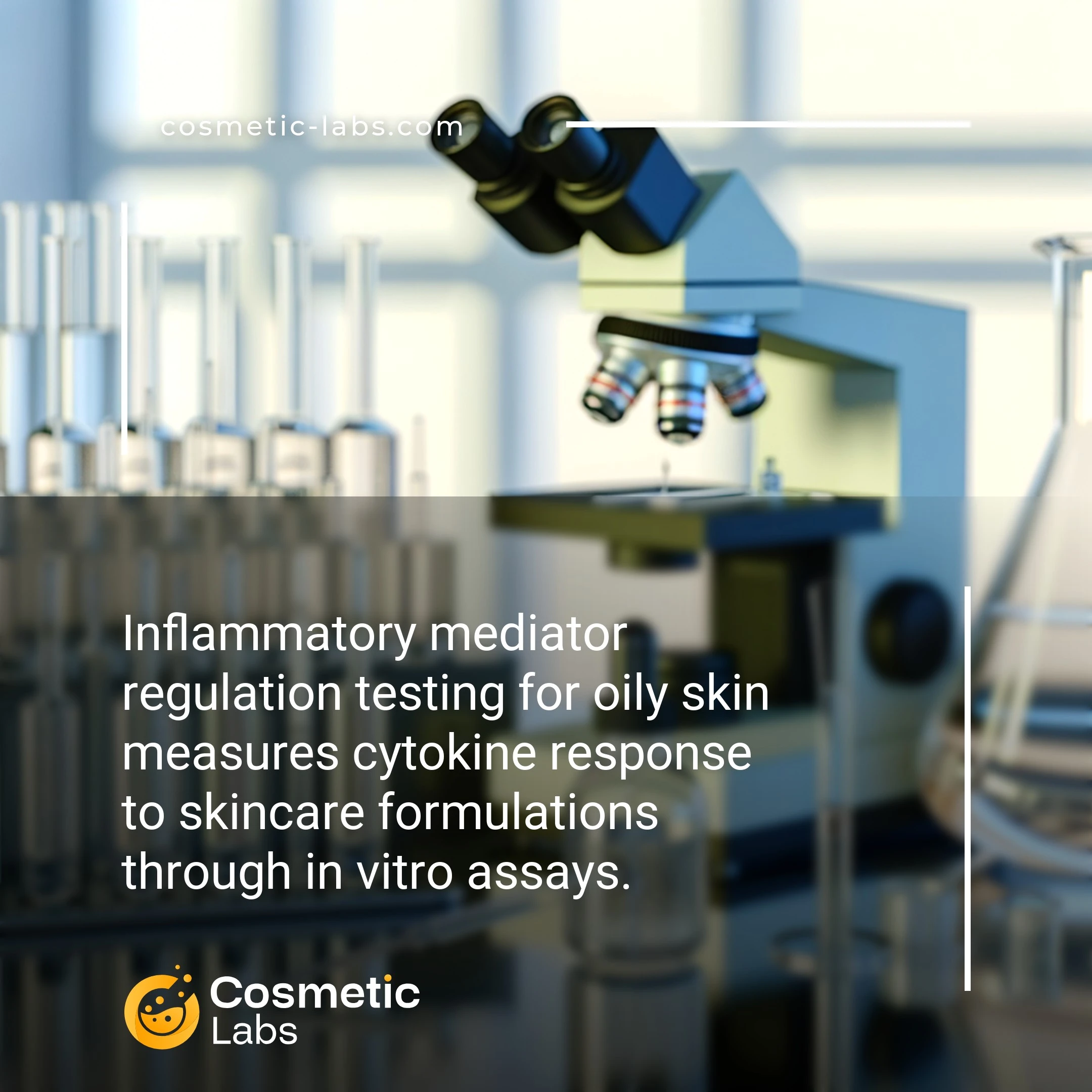Inflammatory Mediator Testing for Oily Skin Products

What is Inflammatory mediators regulation?
Inflammatory mediator regulation testing for oily skin measures how cosmetic ingredients control sebum production and reduce skin inflammation through cytokine analysis and sebaceous gland activity assessment. Our partner labs use in vitro sebocyte cultures and inflammatory biomarker panels to evaluate active compounds like niacinamide and salicylic acid, providing quantitative data on pore-clogging potential and anti-inflammatory efficacy within 2-4 weeks.
Why do you need this service?
Cosmetic labs use inflammatory mediator regulation testing to validate sebum-control formulations before market launch, measuring cytokine reduction and oil production changes in controlled environments. Brands developing acne treatments and mattifying products rely on these protocols to demonstrate measurable anti-inflammatory effects that support marketing claims and regulatory submissions for oily skin solutions.
Who provides Inflammatory mediators regulation services?
All cosmetic labs providing Inflammatory mediators regulation services
There is no company providing these services at the moment.
Inflammatory Mediator Regulation Testing for Oily Skin Products
Inflammatory mediator regulation testing measures how cosmetic formulations control sebaceous gland inflammation and cytokine production in oily skin conditions. Labs use specialized assays to evaluate your product’s ability to reduce inflammatory markers like IL-1β, TNF-α, and prostaglandins that contribute to excess sebum production and skin irritation.
Cytokine Response Analysis
Testing protocols examine how active ingredients modulate pro-inflammatory cytokines in sebocyte cultures and skin tissue models. Labs measure inflammatory markers through ELISA assays and gene expression analysis to quantify your product’s anti-inflammatory effects.
Key inflammatory mediators tested include:
- Interleukin-1 beta (IL-1β) – primary sebaceous inflammation trigger
- Tumor necrosis factor-alpha (TNF-α) – amplifies inflammatory response
- Nuclear factor-kappa B (NF-κB) – regulates inflammatory gene expression
- Cyclooxygenase-2 (COX-2) – produces inflammatory prostaglandins
These tests help validate claims about reducing oily skin inflammation and demonstrate your product’s mechanism of action for regulatory submissions.
Sebaceous Gland Inflammation Models
Specialized testing uses reconstructed sebaceous gland models and ex vivo skin samples to simulate inflammatory conditions found in oily skin. Labs apply inflammatory stimuli like lipopolysaccharides or UV radiation, then measure how your formulation reduces inflammatory responses.
Testing approaches include:
- 3D sebocyte culture models with inflammatory challenge
- Human skin explant studies measuring cytokine release
- Histological analysis of inflammatory cell infiltration
- Real-time PCR for inflammatory gene expression
Results provide concrete data on your product’s ability to calm inflamed sebaceous glands and support marketing claims about reducing oily skin irritation. Connect with specialized cosmetic labs on our platform to discuss inflammatory mediator testing protocols for your oily skin formulations.
Applications of Inflammatory Mediator Regulation Testing for Oily Skin Products
Inflammatory mediator regulation testing for oily skin provides brands with measurable data on how formulations control sebaceous gland activity and reduce inflammatory responses in acne-prone skin.
Product Development and Formulation Optimization
Brands use cytokine profiling to evaluate how ingredients like niacinamide, salicylic acid, and botanical extracts modulate IL-1β, TNF-α, and other inflammatory markers. Labs measure prostaglandin E2 levels and leukotriene production to assess anti-inflammatory efficacy. This data guides formulation adjustments and ingredient concentration optimization.
Testing protocols examine keratinocyte response patterns and sebocyte inflammation markers. Results help brands select effective actives and validate anti-inflammatory claims with quantifiable biomarker data.
Regulatory Compliance and Market Positioning
Inflammatory mediator testing generates documentation for regulatory submissions and substantiates marketing claims about acne treatment and oil control. Labs provide histamine release assays, complement activation studies, and cytokine expression analysis for comprehensive safety profiles.
Brands leverage this testing to differentiate products in competitive markets. Quantified inflammatory response data supports clinical claims and provides scientific backing for product positioning against sebum overproduction and acne-related inflammation.
| Inflammatory Marker | Testing Method | Typical Results Timeline | Application Focus |
|---|---|---|---|
| IL-1β, TNF-α | ELISA assays | 5-7 days | Acne inflammation control |
| Prostaglandin E2 | Immunoassay | 3-5 days | Sebaceous gland regulation |
| Leukotriene B4 | LC-MS/MS | 7-10 days | Pore inflammation reduction |
| Complement C3a/C5a | Fluorescence assay | 4-6 days | Immune response modulation |
Connect with specialized cosmetic labs on our platform to access inflammatory mediator regulation testing services tailored to your oily skin product development needs.
